|
|
|
|||
|
|
||||
|
|
||||
| The Smoky Addiction | ||||
|
|
HOME | SITE MAP | FORUM | CONTACT |
|
||
|
ABOUT | MOTORS | MODELS | ARCHIVE | HISTORY | STORE | FAQ | LINKS
|
|
|
|
|
|
|||||||||||||||||||||||||||||||||||||||||||||||||||||||||
|
The Smoky Addiction 7
(July 2005)
by Roger Simmonds Reprinted from SAM 35 Speaks, July 2005 In his admirable survey of the early issues of Model Aircraft, Knight has concentrated on editorials, articles, club news and contest results, discerning the important advances and trends therein. I also spend much time perusing old magazines, looking for seminal Jetex articles or ground breaking (?) models, but it always takes me longer than expected, as I am constantly diverted by what could be called the ‘incidentals’ – the advertisements, cartoons, and occasional novelties like quiz pages. The artwork of these is generally more individual than today’s computer-generated offerings and always worth looking at. Adverts especially can be as interesting as the more formal articles and more evocative of the mood of the times. I wonder why the 1956 ‘Bettair’ advertisement for the Velojet [above right] features such a desperately old fashioned aeroplane. The somewhat staid Powakits advertisement (from 1947) [right] shows that Howard Boys’ motors were quite expensive at 9/- for “two dozen”. In contrast, the advertisement for V-Max fuel pellets of ten years later (featured Ray Malmström’s delightful drawing [below right], from one of his occasional light-hearted quizzes (Aeromodeller, January 1956) really is a bit of a puzzle. I wouldn’t like to vouch for the safety of the fin. This RATO experiment comes after Fritz Von Opel’s, first rocket hop. I have been unable to find out any more about these experiments; does any reader know where Ray found this reference? Just as a dull and hitherto ignored magazine can be enlivened by its incidentals, an ordinary design, overlooked with some justification by the expert flier can be redeemed by its accompanying article. Bill Winter’s Swish for Jetex 100 [below right], published in the US before Jetex motors were generally available in that country (Model Airplane News, November 1948) is less innovative than Roswell Brown’s contemporaneous Strato-Jet or Henry Struck’s slightly later Jetex Job. However, the description of what happened on the flying field is a fascinating account of learning to fly free flight jets with no prior experience or expectations at all, and one that mirrors some modern modellers’ trials and tribulations with Rapiers. [Ed. Jetex.org has the plan available for download.] Bill Winter, eminent and experienced modeller though he was, needed the practical and moral support of his buddy Walt Shroeder for those first nerve-racking test flights. He writes: “The ship [sic] was trimmed for glide and even given mild tow launches. Then came the big moment. What was going to happen? Would the ship burn up? What would it do under power? How fast would it go? Knowing so little about such a revolutionary development gives one a bad time on the first power launch! A lighted cigarette was put to the fuse which immediately went to town. Now, the Jetex booklet tells you to hang on until you are sure the unit is “jetting”, but until you have “teethed” on a few flights you don’t realise how long this takes. At any rate Walt launched the ship, which, lacking full power, settled in front of him. Picking it up quickly he gave it one of those Brooklyn heaves. Maybe he figured it should go up like a rocket, but three quick launches were followed by three quick stalls and dives. All the while the doting designer was screaming at him to hang on and try a gentle rubber-type launch. In the confusion the neighbour’s sheep stampeded, baaaing and bleating across the field. “By the time the second and third flights had been put in we had the hang of the thing […] you feel the thrust build up as you continue holding the model and then gently launch it almost letting it fly from the hand like a power model. Now we were getting gentle stalls … thrust adjustments are fairly positive […] the position of the Jetex suits the adjustments worked out on the experimental model. […] The Swish is quite impressive. If it should turn it wheels much like a glider. It is suggested that the glide be adjusted for straight ahead flight or with a very slight turn. A turn in the glide tends to build up under power. The turn imparted at the moment of launching seems to govern the direction and degree of bank in the power flight. “Based on the experience of twelve flights [the motor was only supplied with twelve pellets] it would seem that a smaller model than the 30" Swish should exhibit fairly spectacular power performance […] but no make no mistake, the Swish will put up good flights. It is capable of a minimum of 75 feet altitude under power without soaring (which it does very well) and a duration of 1½ min.” This vividly written Winter’s tale is reminiscent of Peter Redhead’s experiences with a Rapier powered Star-jet ((Jet)X Files, February 2004) and John Bowring’s frustrations with the Air-o-jet (August 2004). Both models required a little more sorting out. Peter did achieve a very satisfactory flight performance in the end, but I don’t think either Peter or John ever frightened the local sheep! Bill Winter’s discoveries whilst trimming and flying the Swish, “trim straight, don’t throw, but give a gentle launch” is still most apposite, as is his advice: “construction must be absolutely true with all flying surfaces squarely in alignment […] when you see a free flight model under power without torque you really appreciate the effects of every little twist”. Another of his apprehensions, “the fuse throws fine sparks [and] presents the greatest fire risk, so protect the tissue behind the fuse”, should also be taken to heart. Bill Winter was obviously thrilled by his flying session. Henry Struck, another early Jetex flier, was similarly pleased with the performance of his tailless Jetex Job. His intelligent article (Air Trails Pictorial, February 1949), was subtitled, “The new English solid fuel Jetex engine opens up new avenues of experimentation for model plane designers”. It begins, “Anyone who has thrilled to the smooth, rushing flight of a jet fighter and longed for similar power for his models should find the new Jetex units of special interest”, and later predicts, “Radically new and exciting designs are possible with this new power supply”. |
  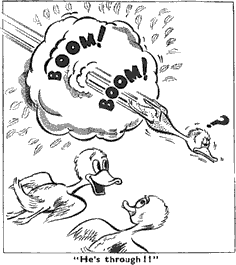 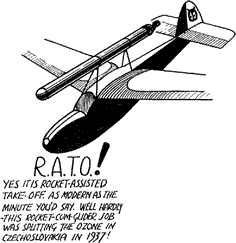
- Aeromodeller, Jan. 1956
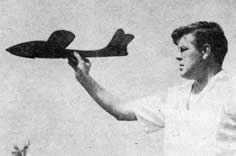
- Model Airplane News, Nov. 1948 (p. 27)
|
|||||||||||||||||||||||||||||||||||||||||||||||||||||||||
|
|
|
|||||

“I built the Wilmot & Mansour flying wing from Tony Betts’ ‘ “I must confess to being worried about the heat from the Rapier, but due to its mounting atop and to the rear, this gave little trouble. The model appeared heavy on initial trials in the breeze at Middle Wallop, where it skimmed the grass in ground effect, pulling 50ft circles. However, I decided to have another go in near perfect conditions at Old Warden in early May. The model was still turning to the left so I added a celluloid trim tab on the right. The transformation was immediate! Using 80mN L2LTs a wondrous steady climb was achieved, resulting in catching a thermal for a short spell. I swiftly ran out of LTs and tried a 110mN L2. Again a welcome surprise, with little wind the speed of climb was very apparent as it soared skywards. Graham [Potter] remarked, ‘You're determined to lose it aren't you?’, but the sun had passed its zenith and the thermals were ebbing. A few more firings produced the same flight pattern, and as long as the launch was steady the model powered to 60-100ft. The glide transition was good with a smashing glide angle and the slow and stable speed produced albatross like effects. I like it!” Note that Andy’s model was initially turning to the left, so the celluloid trim tab was put on the right wing and bent upwards. This stratagem not only causes a rolling effect to the right; the extra drag creates adverse yaw that also helps keep the model straight. Trim tabs giving ‘down aileron’ are generally less effective, as opposite rudder may still be required. Bob Pickernell’s Flying Wings also go well with an L2. He has made three, and their performance, he says, is “stunning”. The first one disappeared upwards at Old Warden; he lost the second on its maiden flight; the last one, which has a longer nose and requires less nose weight, is as yet unflown. According to the advertisements, the original Jetex Flying Wing, one of Harold Figgins’ better inspirations, could be powered by a Jetex 100 as well as the newly introduced 50. It must have been very lively indeed with whole ounce of thrust – is anyone brave or foolish enough to try an L2HP? Even with an L2 some sort of dethermaliser is obviously needed. Nick Peppiat fitted a falling weight mechanism in his Flaming Ptero; perhaps something similar could be attached to the Jetex Flying Wing. Please contact Tony at |
|
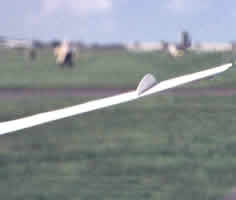
- Andy Blackwell
|
||||
|
I discussed Dick Twomey’s Twizzler and its conversion to Rapier power in May’s Smoky Addiction. When I met Dick at the FROG/Jetex Exhibition (about which more later) he told me he had recently built a replica of his earlier Firecrest [right] for Rapier power. He graciously wrote to me about this, and his memories of the early days of Jetex competition flying, when he was just nineteen and a trainee pilot in the RAF. Dick’s letter begins: “I started Jetex flying with my buddies in our school (Ampleforth College) club in the ’40s, when we tried Jetex motors in all kinds of models with interesting results! By sticking a ‘200’ in a small rubber model I managed to qualify for the first ICI championship at Fairlop in 1949. I had a weekend off from the RAF. The occasion was famous for the presence of several jet models from Argentina [flown proxy] and the enormous first-time-seen ‘Nobel Trophy’. The weather was hot and calm. Scores were in ratios, you could put in one pellet or two, and I chose the latter. Only the longer of two flights counted, so imagine my delight when 28 seconds of fizz resulted in a circling thermal flight of all but ten minutes – 9 min. 50 sec. OOS! “By the time I’d retrieved the Firecrest from nearby streets, Bill Dean had grabbed the plan for his and Ron Warring’s Model Aviation magazine. I went home with the silver Trophy, a £20 cheque and an invitation from the BBC in my hometown Cardiff (I was an Irishman in Wales). “What of the Firecrest? A bit of a tub to look at, but with its Marquardt S2 airfoil it does seem to glide. And we had ways of getting the climb up, although the best of these came later – you bored a hole through the centre of two charges and woof! – but you didn’t get 28 seconds of course!). I produced subsequent Jetex designs, but none was the immediate success of the first one. These were slimmer designs with, eventually, a flat-bottomed wing section to speed up the climb. The Stiletto only came fourth in the Wilmot Mansour trophy, but it did win an open-power competition: great fun to beat a diesel powered model by all of one second!” |
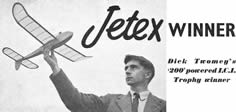
- Model Aviation (UK), Feb. 1950 (p. 20)
|
|||||
|
Clive Hadland came second and Bill Henderson third in that first ICI Championship (see photo right). Dick wonders whether this competition can be revived; if it is, we will have to claim back the magnificent ‘Nobel Trophy’ from the SMAE. First, though, they will have to find it! I wonder what became of it. The trophy, I mean, not the SMAE. Ron Warring’s article in Model Aviation (February 1949) gives more information about the Firecrest: “With the motor mounted above the wing the thrust line coincides, or very nearly so, with the centre of resistance so that optimum trim can be obtained under power and on the glide […] the Firecrest is best flown in a wide circling glide after a straight climb […] any tendency to turn under power can be corrected with rudder, or by offsetting the Jetex unit, or a combination of both.” |
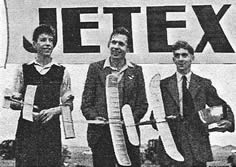 Clive Hadland (2nd)
- Model Aircraft, Nov. 1949 (retouched JMC)
|
|||||

“However,” (writes Warring) “this was found unnecessary, as adequate directional and spiral stability is achieved with just the bottom fin alone.” This feature, repeated in the Twizzler and Stiletto, is, of course, much more compatible with rocket, and especially Rapier, power. Dick concludes his fascinating letter, “I went on to fly other [full size] jets, including 15 years in Tridents, which was exciting too. I am now back to the hobby; let’s fit Rapiers in everything!” I hope he will let me know how he gets on with trimming and flying the Firecrest, and whether the Rapier L4 is an adequate substitute for the original Jetex 200. |
|
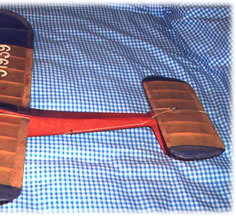
- Dick Twomey
|
||||

Solent Sky FROG/Jetex Exhibition, May 20-22 This event, organised by David Wilmot, David Carpenter, Mike Ingram and Mike Stuart in liaison with Squadron Leader Jones, can be adjudged a great success. Solent Sky were pleased with the numbers who attended, and hopefully this will encourage them to make more of their wonderful (and sadly underrated) permanent ‘Model Shop’ display [right]. Perhaps some sort of Wilmot Mansour celebration can be held every year. Friday evening’s reunion of Wilmot Mansour employees from the early days at Totton was quite an occasion and very well supported. The Mayor and a local MP (whose speech opened the show) were there, but Bert Judge [below] with his pre-war Wakefield winner was definitely the star. Other distinguished guests included Ron Moulton, Mike Ingram, Peter Cock, Ian Dowsett, Jeremy Mansour, our two previous Jetex columnists, John Emmett and Terry Kidd, and, all the way from Arizona, the irrepressible Ben Nead of the Jetex.org website.
Despite the rival attractions of a Cup Final and a model show in London we entertained a steady stream of visitors on both days. For many it must have been quite a nostalgic trip, and I hope the live exhibits and Mike Stuart’s all-action video CD, which was playing continuously to appreciative audiences, not only brought back memories, but also inspired some to return to the delights of their youth. Mike still has copies of ‘Just Jets, free flight flying scale jets in action 2002-2004,’ so please contact him if you would like one. Andy, Ben and I thoroughly enjoyed ourselves, losing no opportunity to preach the joys of Jetex and the rewards or Rapiers. Conversation was by no means one way, of course. Inevitably, and unsurprisingly, given the knowledge and experience of visitors like Dick Twomey, we were the recipients of many reminiscences. These contacts will be followed up in due course and we hope that some gaps in our ‘Jetex History’ saga can eventually be filled in. I’ve no doubt much will be written about the other displays, which were all superb. There was, however, one small disappointment for me (apart from not being able to get my hands on a copy of Lines and Hellstrom’s history of FROG (FROG Model Aircraft 1932-1976), which sadly is still out of print). Jetex produced a number of 1/144 plastic construction kits in the latter half of the fifties. They were not, according to Bert, who was responsible for their design and tooling, a great commercial success. An advertisement from the January 1956 Aeromodeller (right) for the “Sensational Wimco Hollows” (as opposed to ‘solids’) tells us that the range included a Javelin, Canberra and Valiant. There were, alas, none at the exhibition, and I have yet to see any of these rare models in the flesh, or meet anyone else who knows anything about them. Should the Wimco advertisement jog a reader’s memory of making one of these models, (a) it will prove some of what I’ve been saying about advertisements, and (b) please write to me. |
|
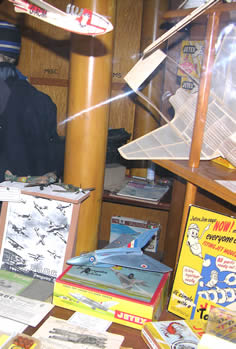
- David Lloyd-Jones
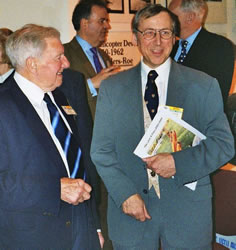
- Andy Blackwell
 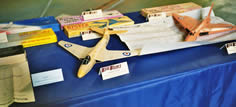 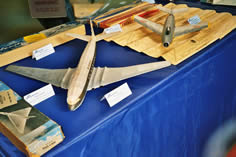
- Andy Blackwell
 |
||||
|
|
||||||
|
|
||||||
|
|
|
|||||
|
|
|
|
|
|
|
|
Acknowledgements - Article: Roger Simmonds - Illustrations: Roger Simmonds, Andy Blackwell, Bill Henderson, MAAC archives via Bill Henderson, Ben Nead, Mike Stuart |
|
|
|
|
ABOUT | MOTORS | MODELS | ARCHIVE | HISTORY | STORE | FAQ | LINKS |
|
|
Terms of Use
|
Queries? Corrections? Additions?
Please
contact us.
|
|